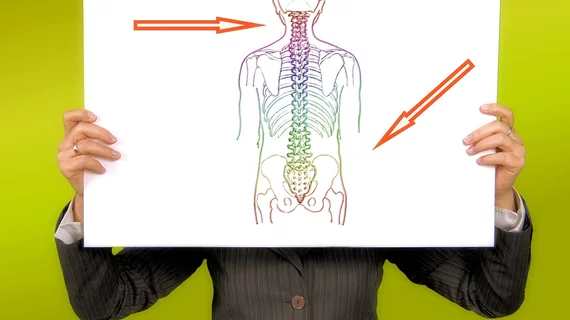Standardizing how providers classify spine degradation in MRI reports can help bolster agreement between neuro and musculoskeletal radiologists, according to a new investigation.
Magnetic resonance imaging is the go-to modality when planning treatment for patients with lower back pain or similar concerns. But substantial variability in interpretation exists between rad subspecialties and spine clinicians, experts detailed recently in Current Problems in Diagnostic Radiology.
Brigham and Women’s Hospital sought to establish more uniformity, creating a standardized training for physicians on four different parameters in spine reporting. It appears to be paying off in the early stages.
“The results suggest this classification may be a clinically useful tool to improve the consistency of reporting lumbar spine MRI exams for both subspecialties,” Nityanand Miskin, MD, with Brigham and Women's Department of Radiology, and co-authors wrote Aug. 28.
Providers picked four specific parameters in spine reporting to address, noting their clinical relevance, with each possible targets for injections or decompressive surgery. Those included spinal narrowing (spinal canal stenosis), compression of spinal nerves as they leave the canal (neural foraminal stenosis) or just before reaching the intervertebral foramen (lateral recess stenosis), and degenerative changes to the joints between bones (facet osteoarthritis). Brigham and Women’s conferred with radiologists, spine surgeons, physiatrists and orthopedists to help standardize MRI reporting terminology across disciplines.
Six radiologists split evenly between neuro and musculoskeletal subspecialities were trained on this new classification system of degenerative change. Following an 11-month pause period, rads independently reinterpreted 50 exams, with investigators converting their responses to a numbered scale to compare. Inter-subspecialty agreement improved from “moderate” to “substantial” for neural foraminal stenosis; moderate to substantial on spinal canal stenosis; “slight” to “fair” on lateral recess stenosis; and slight to moderate on facet osteoarthritis. Meanwhile, Miskin and co-investigators also noted improved agreement on certain parameters among neuroradiologists and MSK experts.
“The extent to which a reduction in variability translates to any improvement in patient outcomes is unknown, and is a potential topic for future work, potentially with the aid of this classification to investigate if the severity distinctions made in this classification system translate to improvement after conservative or procedural interventions,” the authors cautioned.

